An Emerging Bacterial Leaf Disease in Rice Caused by Pantoea ananatis and Pantoea eucalypti in Northeast China
Abstract
1. Introduction
2. Materials and Methods
2.1. Pathogen Isolation and Purification
2.2. Pathogen Identification by Koch’s Postulates
2.3. Pathogen Identification by Multilocus Sequence Analysis (MLSA)
2.4. Phylogenetic Tree Construction
2.5. Detection of Extracellular Enzymes
2.6. Whole Genome Sequencing and Gene Annotation
2.7. Pathogenicity-Associated Component Analysis
3. Results
3.1. Incidence and Symptoms of a New Rice Bacterial Disease
3.2. Identification of the Causal Agent Based on Koch’s Postulates
3.3. Identification of P. ananatis and P. eucalypti
3.4. Genome Sequencing, Assembly, and Functional Annotation
3.5. Comparative Analysis of Virulence Factors
4. Discussion
5. Conclusions
Supplementary Materials
Author Contributions
Funding
Institutional Review Board Statement
Informed Consent Statement
Data Availability Statement
Conflicts of Interest
References
- Li, D.; Li, S.; Wei, S.; Sun, W. Strategies to manage rice sheath blight: Lessons from interactions between rice and Rhizoctonia solani. Rice 2021, 14, 21. [Google Scholar] [CrossRef] [PubMed]
- Liu, Z.; Zhu, Y.; Shi, H.; Qiu, J.; Ding, X.; Kou, Y. Recent progress in rice broad-spectrum disease resistance. Int. J. Mol. Sci. 2021, 22, 11658. [Google Scholar] [CrossRef] [PubMed]
- Sun, W.; Fan, J.; Fang, A.; Li, Y.; Tariqjaveed, M.; Li, D.; Hu, D.; Wang, W.-M. Ustilaginoidea virens: Insights into an emerging rice pathogen. Annu. Rev. Phytopathol. 2020, 58, 363–385. [Google Scholar] [CrossRef]
- Cother, E.J.; Reinke, R.; McKenzie, C.; Lanoiselet, V.; Noble, D. An unusual stem necrosis of rice caused by Pantoea ananas and the first record of this pathogen on rice in Australia. Australas. Plant Pathol. 2004, 33, 495–503. [Google Scholar] [CrossRef]
- Egorova, M.; Mazurin, E.; Ignatov, A. First report of Pantoea ananatis causing grain discolouration and leaf blight of rice in Russia. New Dis. Rep. 2015, 32, 21. [Google Scholar] [CrossRef]
- Choi, O.-H.; Kim, H.-Y.; Lee, Y.-S.; Kim, J.-W.; Moon, J.-S.; Hwang, I.-G. First report of sheath rot of rice caused by Pantoea ananatis in Korea. Plant Pathol. J. 2012, 28, 331. [Google Scholar] [CrossRef]
- Lee, H.; Hong, J.; Kim, S. First report of leaf blight caused by Pantoea agglomerans on rice in Korea. Plant Dis. 2010, 94, 1372. [Google Scholar] [CrossRef] [PubMed]
- Mondal, K.; Mani, C.; Singh, J.; Kim, J.-G.; Mudgett, M. A new leaf blight of rice caused by Pantoea ananatis in India. Plant Dis. 2011, 95, 1582. [Google Scholar] [CrossRef]
- Xue, Y.; Hu, M.; Chen, S.; Hu, A.; Li, S.; Han, H.; Lu, G.; Zeng, L.; Zhou, J. Enterobacter asburiae and Pantoea ananatis causing rice bacterial blight in China. Plant Dis. 2021, 105, 2078–2088. [Google Scholar] [CrossRef]
- Yan, H.; Yu, S.; Xie, G.; Fang, W.; Su, T.; Li, B. Grain discoloration of rice caused by Pantoea ananatis (synonym Erwinia uredovora) in China. Plant Dis. 2010, 94, 482. [Google Scholar] [CrossRef]
- Yu, L.; Yang, C.; Ji, Z.; Zeng, Y.; Liang, Y.; Hou, Y. First report of new bacterial leaf blight of rice caused by Pantoea ananatis in Southeast China. Plant Dis. 2022, 106, 310. [Google Scholar] [CrossRef] [PubMed]
- De Maayer, P.; Chan, W.Y.; Venter, S.N.; Toth, I.K.; Birch, P.R.; Joubert, F.; Coutinho, T.A. Genome sequence of Pantoea ananatis LMG20103, the causative agent of Eucalyptus blight and dieback. J. Bacteriol. 2010, 192, 2936–2937. [Google Scholar] [CrossRef] [PubMed]
- Yuan, T.; Huang, Y.; Luo, L.; Wang, J.; Li, J.; Chen, J.; Qin, Y.; Liu, J. Complete Genome sequence of Pantoea ananatis strain LCFJ-001 isolated from bacterial wilt mulberry. Plant Dis. 2023, 107, 2500–2505. [Google Scholar] [CrossRef]
- Asselin, J.A.E.; Bonasera, J.M.; Helmann, T.C.; Beer, S.V.; Stodghill, P.V. Complete genome sequence resources for the onion pathogen, Pantoea ananatis OC5a. Phytopathology 2021, 111, 1885–1888. [Google Scholar] [CrossRef] [PubMed]
- Wu, L.; Liu, R.; Niu, Y.; Lin, H.; Ye, W.; Guo, L.; Hu, X. Whole genome sequence of Pantoea ananatis R100, an antagonistic bacterium isolated from rice seed. J. Biotechnol. 2016, 225, 1–2. [Google Scholar] [CrossRef]
- Kim, H.J.; Lee, J.H.; Kang, B.R.; Rong, X.; McSpadden Gardener, B.B.; Ji, H.J.; Park, C.-S.; Kim, Y.C. Draft genome sequence of Pantoea ananatis B1-9, a nonpathogenic plant growth-promoting bacterium. J. Bacteriol. 2012, 194, 729. [Google Scholar] [CrossRef]
- Bing, X.-L.; Wan, Y.-Y.; Liu, H.-H.; Ji, R.; Zhao, D.-S.; Niu, Y.-D.; Li, T.-P.; Hong, X.-Y. Characterization of Pantoea ananatis from rice planthoppers reveals a clade of rice-associated P. ananatis undergoing genome reduction. Microb. Genom. 2022, 8, 000907. [Google Scholar] [CrossRef]
- De Maayer, P.; Chan, W.Y.; Rezzonico, F.; Bühlmann, A.; Venter, S.N.; Blom, J.; Goesmann, A.; Frey, J.E.; Smits, T.H.; Duffy, B. Complete genome sequence of clinical isolate Pantoea ananatis LMG 5342. J. Bacteriol. 2012, 194, 1615–1616. [Google Scholar] [CrossRef]
- Kini, K.; Lefeuvre, P.; Poulin, L.; Silué, D.; Koebnik, R. Genome resources of three West African strains of Pantoea ananatis causing bacterial blight and grain discoloration of rice. Phytopathology 2020, 110, 1500–1502. [Google Scholar] [CrossRef]
- Song, Z.; Lu, Y.; Liu, X.; Wei, C.; Oladipo, A.; Fan, B. Evaluation of Pantoea eucalypti FBS135 for pine (Pinus massoniana) growth promotion and its genome analysis. J. Appl. Microbiol. 2020, 129, 958–970. [Google Scholar] [CrossRef]
- Wei, C.; Song, Z.; Lu, Y.; Zhao, Y.; Fan, B. Relationship of the Pine Growth Promoting Pantoea eucalypti FBS135 with Type Strains P. eucalypti LMG 24197T and P. vagans 24199T. Life 2021, 11, 608. [Google Scholar] [CrossRef]
- De Maayer, P.; Chan, W.Y.; Rubagotti, E.; Venter, S.N.; Toth, I.K.; Birch, P.R.; Coutinho, T.A. Analysis of the Pantoea ananatis pan-genome reveals factors underlying its ability to colonize and interact with plant, insect and vertebrate hosts. BMC Genom. 2014, 15, 404. [Google Scholar] [CrossRef]
- Weller-Stuart, T.; De Maayer, P.; Coutinho, T. Pantoea ananatis: Genomic insights into a versatile pathogen. Mol. Plant Pathol. 2017, 18, 1191–1198. [Google Scholar] [CrossRef] [PubMed]
- Deng, W.; Marshall, N.C.; Rowland, J.L.; McCoy, J.M.; Worrall, L.J.; Santos, A.S.; Strynadka, N.C.; Finlay, B.B. Assembly, structure, function and regulation of type III secretion systems. Nat. Rev. Microbiol. 2017, 15, 323–337. [Google Scholar] [CrossRef]
- Naskar, S.; Hohl, M.; Tassinari, M.; Low, H.H. The structure and mechanism of the bacterial type II secretion system. Mol. Microbiol. 2021, 115, 412–424. [Google Scholar] [CrossRef] [PubMed]
- Stice, S.P.; Stumpf, S.D.; Gitaitis, R.D.; Kvitko, B.H.; Dutta, B. Pantoea ananatis genetic diversity analysis reveals limited genomic diversity as well as accessory genes correlated with onion pathogenicity. Front. Microbiol. 2018, 9, 184. [Google Scholar] [CrossRef]
- Asselin, J.A.E.; Bonasera, J.M.; Beer, S.V. Center rot of onion (Allium cepa) caused by Pantoea ananatis requires pepM, a predicted phosphonate-related gene. Mol. Plant-Microbe Interact. 2018, 31, 1291–1300. [Google Scholar] [CrossRef] [PubMed]
- Myers, B.K.; Shin, G.Y.; Agarwal, G.; Stice, S.P.; Gitaitis, R.D.; Kvitko, B.H.; Dutta, B. Genome-wide association and dissociation studies in Pantoea ananatis reveal potential virulence factors affecting Allium porrum and Allium fistulosum× Allium cepa hybrid. Front. Microbiol. 2023, 13, 1094155. [Google Scholar] [CrossRef]
- Stice, S.P.; Shin, G.Y.; De Armas, S.; Koirala, S.; Galván, G.A.; Siri, M.I.; Severns, P.M.; Coutinho, T.; Dutta, B.; Kvitko, B.H. The distribution of onion virulence gene clusters among Pantoea spp. Front. Plant Sci. 2021, 12, 643787. [Google Scholar] [CrossRef]
- Stice, S.P.; Thao, K.K.; Khang, C.H.; Baltrus, D.A.; Dutta, B.; Kvitko, B.H. Thiosulfinate tolerance is a virulence strategy of an atypical bacterial pathogen of onion. Curr. Biol. 2020, 30, 3130–3140. [Google Scholar] [CrossRef]
- Agarwal, G.; Choudhary, D.; Stice, S.P.; Myers, B.K.; Gitaitis, R.D.; Venter, S.N.; Kvitko, B.H.; Dutta, B. Pan-genome-wide analysis of Pantoea ananatis identified genes linked to pathogenicity in onion. Front. Microbiol. 2021, 12, 684756. [Google Scholar] [CrossRef] [PubMed]
- Fang, Z.D. Research Methods on Plant Pathology; China Agricultural Press: Beijing, China, 1998. [Google Scholar]
- Ke, Y.; Hui, S.; Yuan, M. Xanthomonas oryzae pv. oryzae Inoculation and Growth Rate on Rice by Leaf Clipping Method. Bio-protocol 2017, 7, e2568. [Google Scholar] [CrossRef] [PubMed]
- Ross, L.N.; Woodward, J.F. Koch’s postulates: An interventionist perspective. Stud. Hist. Philos. Biol. Biomed. Sci. 2016, 59, 35–46. [Google Scholar] [CrossRef]
- De Armas, S.; Galvan, G.A.; Lapaz, M.I.; Gonzalez-Barrios, P.; Vicente, E.; Pianzzola, M.J.; Siri, M.I. Phylogeny and Identification of Pantoea Species Associated with Bulb Rot and Bacterial Leaf Blight of Onion Crops in Uruguay. Plant Dis. 2022, 106, 1216–1225. [Google Scholar] [CrossRef]
- Delétoile, A.; Decré, D.; Courant, S.; Passet, V.; Audo, J.; Grimont, P.; Arlet, G.; Brisse, S. Phylogeny and identification of Pantoea species and typing of Pantoea agglomerans strains by multilocus gene sequencing. J. Clin. Microbiol. 2009, 47, 300–310. [Google Scholar] [CrossRef] [PubMed]
- Salerno, A.; Delétoile, A.; Lefevre, M.; Ciznar, I.; Krovacek, K.; Grimont, P.; Brisse, S. Recombining population structure of Plesiomonas shigelloides (Enterobacteriaceae) revealed by multilocus sequence typing. J. Biotechnol. 2007, 189, 7808–7818. [Google Scholar] [CrossRef]
- Wei, C.; Wang, S.; Liu, P.; Cheng, S.-T.; Qian, G.; Wang, S.; Fu, Y.; Qian, W.; Sun, W. The PdeK-PdeR two-component system promotes unipolar localization of FimX and pilus extension in Xanthomonas oryzae pv. oryzicola. Sci. Signal. 2021, 14, eabi9589. [Google Scholar] [CrossRef]
- Ronquist, F.; Teslenko, M.; Van Der Mark, P.; Ayres, D.L.; Darling, A.; Höhna, S.; Larget, B.; Liu, L.; Suchard, M.A.; Huelsenbeck, J.P. MrBayes 3.2: Efficient Bayesian phylogenetic inference and model choice across a large model space. Syst. Biol. 2012, 61, 539–542. [Google Scholar] [CrossRef]
- Nguyen, L.-T.; Schmidt, H.A.; Von Haeseler, A.; Minh, B.Q. IQ-TREE: A fast and effective stochastic algorithm for estimating maximum-likelihood phylogenies. Mol. Biol. Evol. 2015, 32, 268–274. [Google Scholar] [CrossRef]
- Koren, S.; Walenz, B.P.; Berlin, K.; Miller, J.R.; Bergman, N.H.; Phillippy, A.M. Canu: Scalable and accurate long-read assembly via adaptive k-mer weighting and repeat separation. Genome Res. 2017, 27, 722–736. [Google Scholar] [CrossRef]
- Vaser, R.; Sović, I.; Nagarajan, N.; Šikić, M. Fast and accurate de novo genome assembly from long uncorrected reads. Genome Res. 2017, 27, 737–746. [Google Scholar] [CrossRef] [PubMed]
- Hunt, M.; Silva, N.D.; Otto, T.D.; Parkhill, J.; Keane, J.A.; Harris, S.R. Circlator: Automated circularization of genome assemblies using long sequencing reads. Genome Biol. 2015, 16, 294. [Google Scholar] [CrossRef] [PubMed]
- Cumsille, A.; Durán, R.E.; Rodríguez-Delherbe, A.; Saona-Urmeneta, V.; Cámara, B.; Seeger, M.; Araya, M.; Jara, N.; Buil-Aranda, C. GenoVi, an open-source automated circular genome visualizer for bacteria and archaea. PLoS Comput. Biol. 2023, 19, e1010998. [Google Scholar] [CrossRef]
- Jain, C.; Rodriguez-R, L.M.; Phillippy, A.M.; Konstantinidis, K.T.; Aluru, S. High throughput ANI analysis of 90K prokaryotic genomes reveals clear species boundaries. Nat. Commun. 2018, 9, 5114. [Google Scholar] [CrossRef]
- Emms, D.M.; Kelly, S. OrthoFinder: Phylogenetic orthology inference for comparative genomics. Genome Biol. 2019, 20, 238. [Google Scholar] [CrossRef]
- Néron, B.; Denise, R.; Coluzzi, C.; Touchon, M.; Rocha, E.P.; Abby, S.S. MacSyFinder v2: Improved modelling and search engine to identify molecular systems in genomes. Peer Community J. 2023, 3, 24072. [Google Scholar] [CrossRef]
- Bertelli, C.; Brinkman, F.S. Improved genomic island predictions with IslandPath-DIMOB. Bioinformatics 2018, 34, 2161–2167. [Google Scholar] [CrossRef]
- Urban, M.; Cuzick, A.; Seager, J.; Wood, V.; Rutherford, K.; Venkatesh, S.Y.; Sahu, J.; Iyer, S.V.; Khamari, L.; De Silva, N.; et al. PHI-base in 2022: A multi-species phenotype database for Pathogen-Host Interactions. Nucleic Acids Res. 2022, 50, D837–D847. [Google Scholar] [CrossRef]
- Blin, K.; Shaw, S.; Kloosterman, A.M.; Charlop-Powers, Z.; Van Wezel, G.P.; Medema, M.H.; Weber, T. antiSMASH 6.0: Improving cluster detection and comparison capabilities. Nucleic Acids Res. 2021, 49, W29–W35. [Google Scholar] [CrossRef]
- Zou, H.-S.; Song, X.; Zou, L.-F.; Yuan, L.; Li, Y.-R.; Guo, W.; Che, Y.-Z.; Zhao, W.-X.; Duan, Y.-P.; Chen, G.-Y. EcpA, an extracellular protease, is a specific virulence factor required by Xanthomonas oryzae pv. oryzicola but not by X. oryzae pv. oryzae in rice. Microbiology 2012, 158, 2372–2383. [Google Scholar] [CrossRef]
- Brady, C.L.; Venter, S.N.; Cleenwerck, I.; Engelbeen, K.; Vancanneyt, M.; Swings, J.; Coutinho, T.A. Pantoea vagans sp. nov., Pantoea eucalypti sp. nov., Pantoea deleyi sp. nov. and Pantoea anthophila sp. nov. Int. J. Syst. Evol. Microbiol. 2009, 59, 2339–2345. [Google Scholar] [CrossRef] [PubMed]
- Serrano, F.B. Bacterial fruitlet brown rot of pineapples in the Philippines. Philipp. J. Sci. 1928, 3, 271–305. [Google Scholar]
- Adam, Z.; Tambong, J.T.; Lewis, C.T.; Lévesque, C.A.; Chen, W.; Bromfield, E.S.; Khan, I.U.; Xu, R. Draft genome sequence of Pantoea ananatis strain LMG 2665T, a bacterial pathogen of pineapple fruitlets. Genome Announc. 2014, 2, 10–1128. [Google Scholar] [CrossRef] [PubMed]
- Coutinho, T.; Preisig, O.; Mergaert, J.; Cnockaert, M.; Riedel, K.-H.; Swings, J.; Wingfield, M. Bacterial blight and dieback of Eucalyptus species, hybrids, and clones in South Africa. Plant Dis. 2002, 86, 20–25. [Google Scholar] [CrossRef]
- Goszczynska, T.; Botha, W.; Venter, S.; Coutinho, T. Isolation and identification of the causal agent of brown stalk rot, a new disease of maize in South Africa. Plant Dis. 2007, 91, 711–718. [Google Scholar] [CrossRef]
- Kini, K.; Agnimonhan, R.; Afolabi, O.; Soglonou, B.; Silué, D.; Koebnik, R. First report of a new bacterial leaf blight of rice caused by Pantoea ananatis and Pantoea stewartii in Togo. Plant Dis. 2017, 101, 241. [Google Scholar] [CrossRef]
- Cota, L.; Costa, R.; Silva, D.; Parreira, D.; Lana, U.; Casela, C. First report of pathogenicity of Pantoea ananatis in sorghum (Sorghum bicolor) in Brazil. Australas. Plant Pathol. 2010, 5, 120–122. [Google Scholar] [CrossRef]
- Krawczyk, K.; Wielkopolan, B.; Obrępalska-Stęplowska, A. Pantoea ananatis, a new bacterial pathogen affecting wheat plants (Triticum L.) in Poland. J. Pathog. 2020, 9, 1079. [Google Scholar] [CrossRef]
- Guevarra, R.B.; Magez, S.; Peeters, E.; Chung, M.S.; Kim, K.H.; Radwanska, M. Comprehensive genomic analysis reveals virulence factors and antibiotic resistance genes in Pantoea agglomerans KM1, a potential opportunistic pathogen. PLoS ONE 2021, 16, e0239792. [Google Scholar] [CrossRef]
- Shyntum, D.Y.; Theron, J.; Venter, S.N.; Moleleki, L.N.; Toth, I.K.; Coutinho, T.A. Pantoea ananatis utilizes a type VI secretion system for pathogenesis and bacterial competition. Mol. Plant-Microbe Interact. 2015, 28, 420–431. [Google Scholar] [CrossRef]
- Chang, J.H.; Desveaux, D.; Creason, A.L. The ABCs and 123s of bacterial secretion systems in plant pathogenesis. Annu. Rev. Phytopahtol. 2014, 52, 317–345. [Google Scholar] [CrossRef] [PubMed]
- Nissan, G.; Gershovits, M.; Morozov, M.; Chalupowicz, L.; Sessa, G.; Manulis-Sasson, S.; Barash, I.; Pupko, T. Revealing the inventory of type III effectors in Pantoea agglomerans gall-forming pathovars using draft genome sequences and a machine-learning approach. Mol. Plant Pathol. 2018, 19, 381–392. [Google Scholar] [CrossRef] [PubMed]
- Zhao, M.; Shin, G.Y.; Stice, S.; Bown, J.L.; Coutinho, T.; Metcalf, W.W.; Gitaitis, R.; Kvitko, B.; Dutta, B. A novel biosynthetic gene cluster across the Pantoea species complex is important for pathogenicity in onion. Mol. Plant-Microbe Interact. 2023, 36, 176–188. [Google Scholar] [CrossRef]
- Polidore, A.L.; Furiassi, L.; Hergenrother, P.J.; Metcalf, W.W. A phosphonate natural product made by Pantoea ananatis is necessary and sufficient for the hallmark lesions of onion center rot. MBio 2021, 12, 10–1128. [Google Scholar] [CrossRef]
- Hwang, I.S.; Oh, E.-J.; Lee, H.B.; Oh, C.-S. Functional characterization of two cellulase genes in the Gram-positive pathogenic bacterium Clavibacter michiganensis for wilting in tomato. Mol. Plant-Microbe Interact. 2019, 32, 491–501. [Google Scholar] [CrossRef]
- Tayi, L.; Kumar, S.; Nathawat, R.; Haque, A.S.; Maku, R.V.; Patel, H.K.; Sankaranarayanan, R.; Sonti, R.V. A mutation in an exoglucanase of Xanthomonas oryzae pv. oryzae, which confers an endo mode of activity, affects bacterial virulence, but not the induction of immune responses, in rice. Mol. Plant Pathol. 2018, 19, 1364–1376. [Google Scholar] [CrossRef] [PubMed]
- Boehm, M.; Hoy, B.; Rohde, M.; Tegtmeyer, N.; Bæk, K.T.; Oyarzabal, O.A.; Brøndsted, L.; Wessler, S.; Backert, S. Rapid paracellular transmigration of Campylobacter jejuni across polarized epithelial cells without affecting TER: Role of proteolytic-active HtrA cleaving E-cadherin but not fibronectin. Gut Pathog. 2012, 4, 3. [Google Scholar] [CrossRef]
- Chitlaru, T.; Israeli, M.a.; Bar-Haim, E.; Elia, U.; Rotem, S.; Ehrlich, S.; Cohen, O.; Shafferman, A. Next-generation Bacillus anthracis live attenuated spore vaccine based on the htrA-(high temperature requirement A) Sterne strain. Sci. Rep. 2016, 6, 18908. [Google Scholar] [CrossRef]
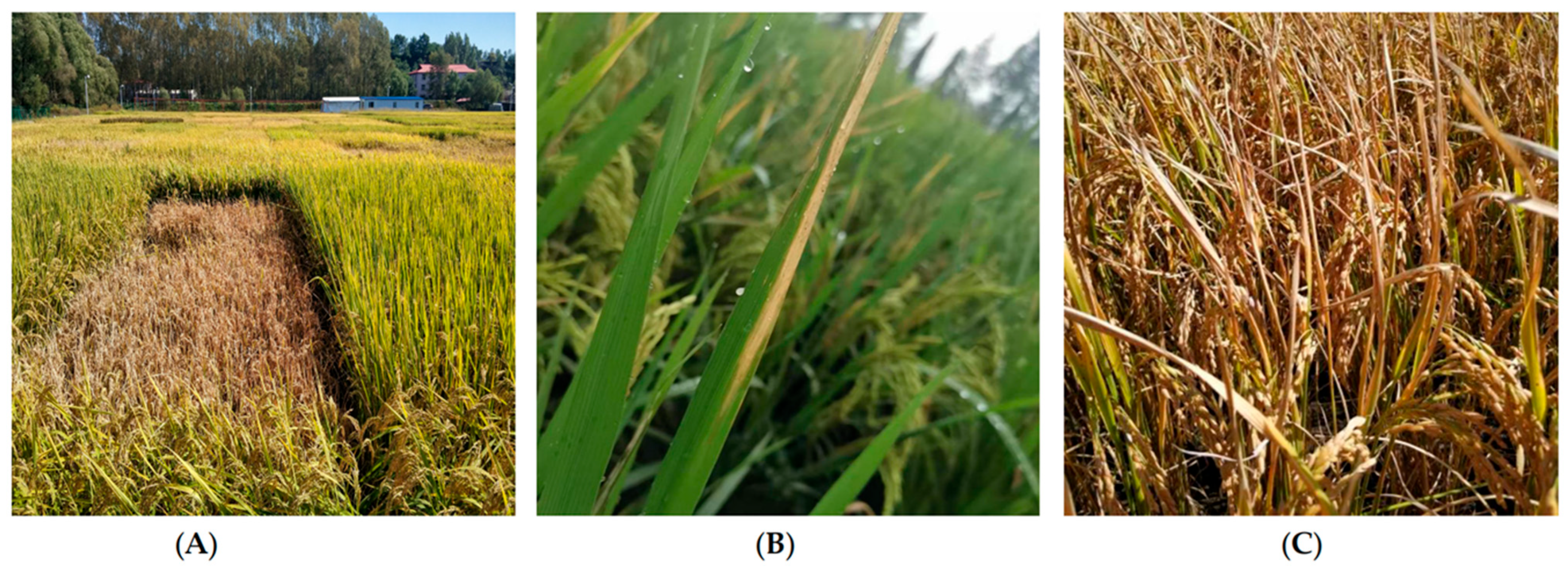
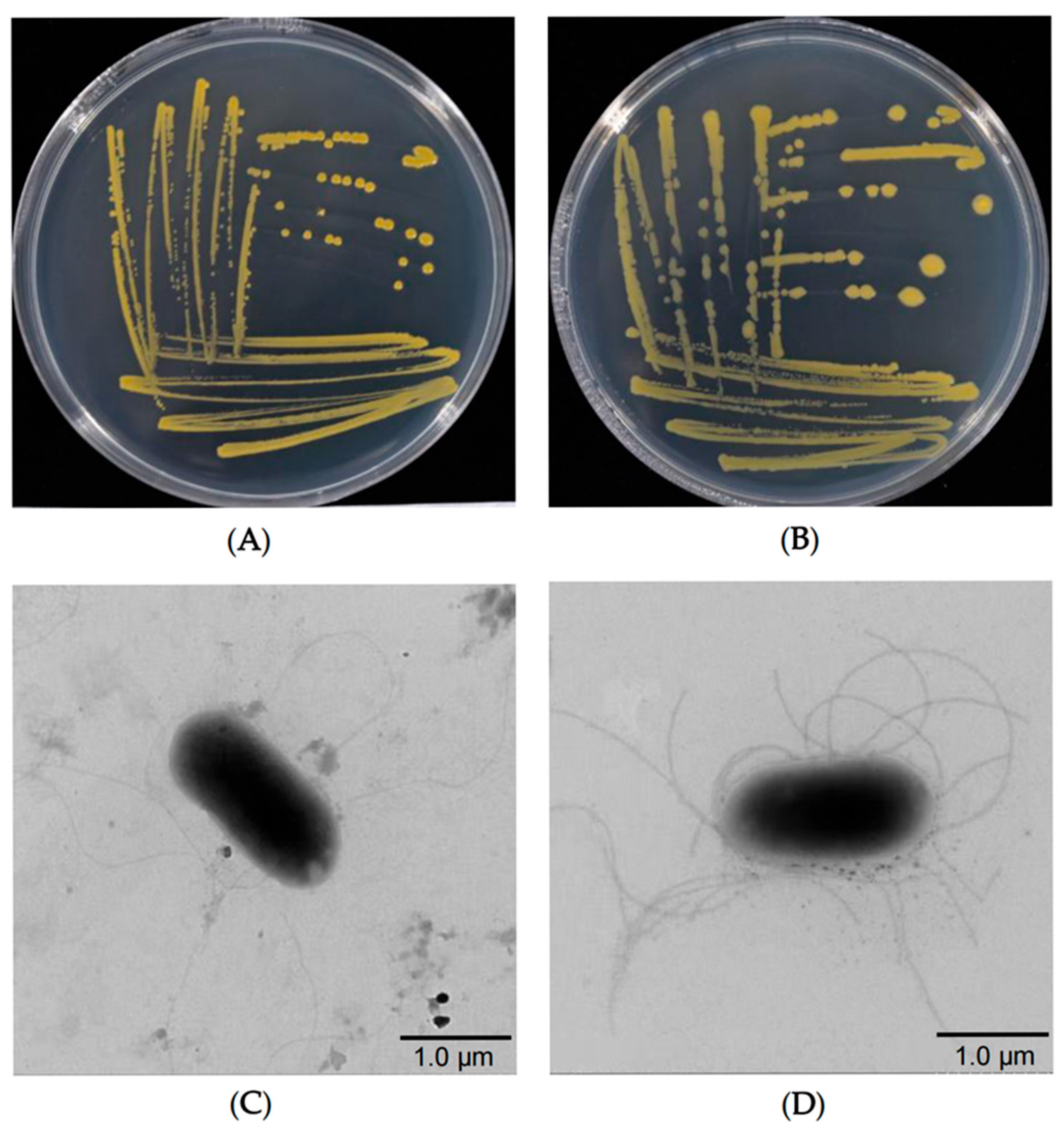
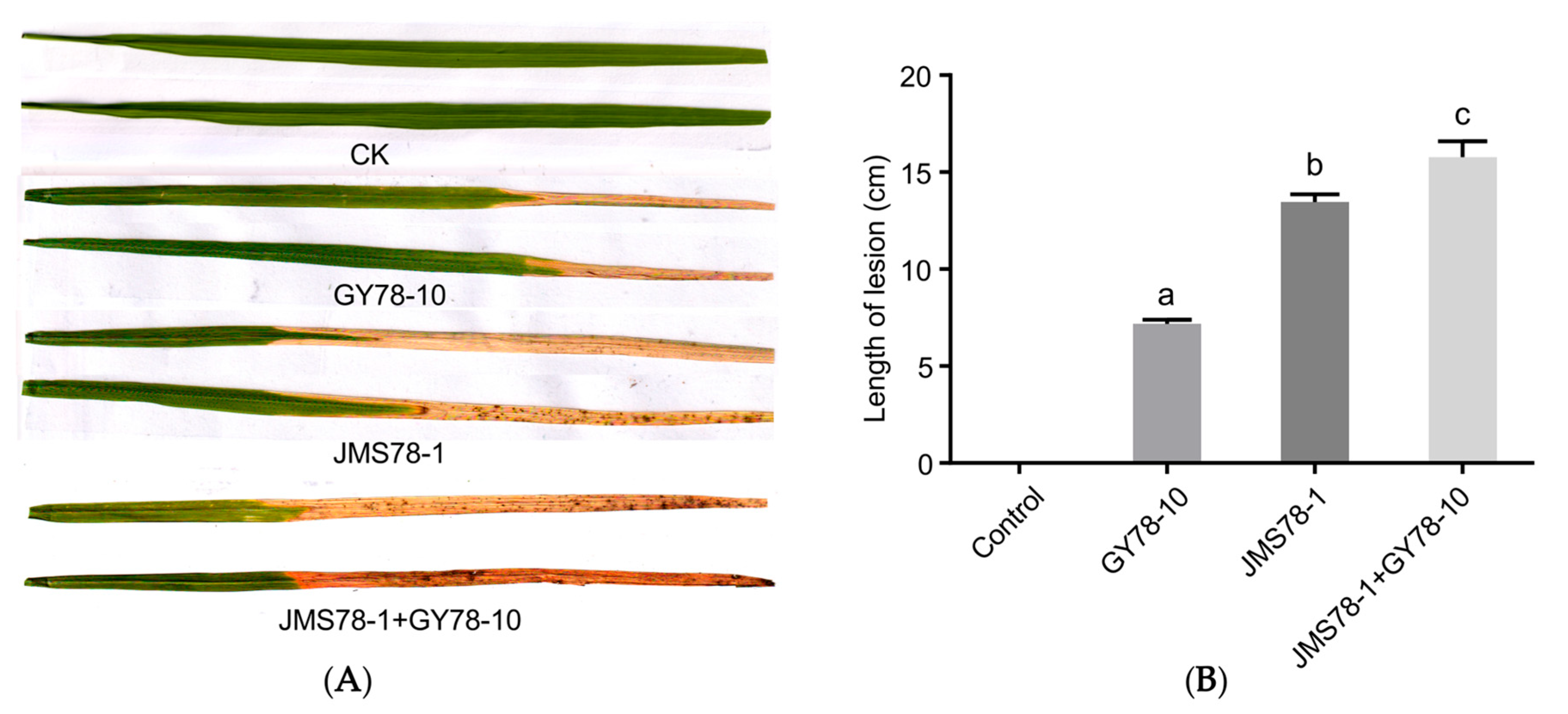
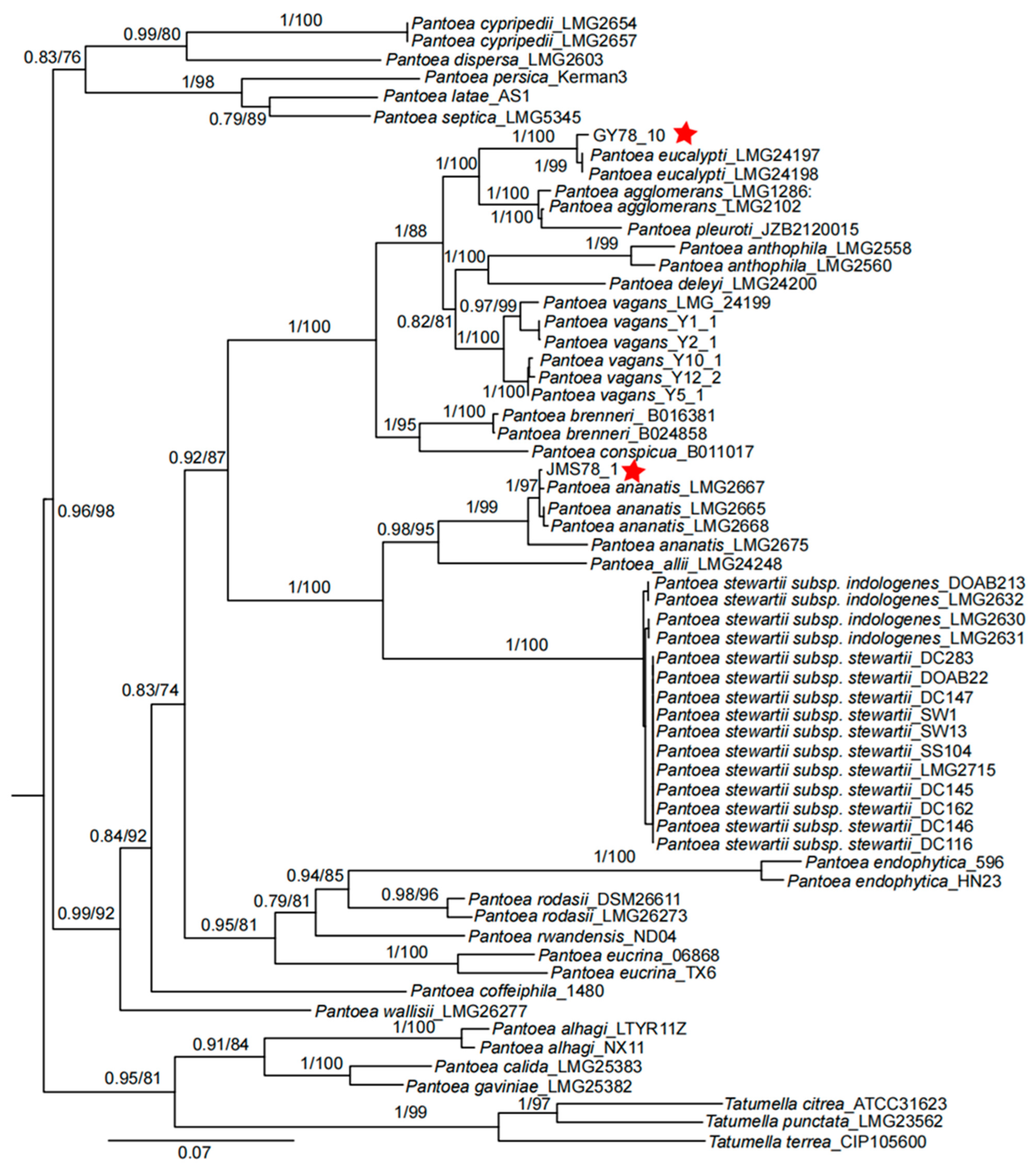
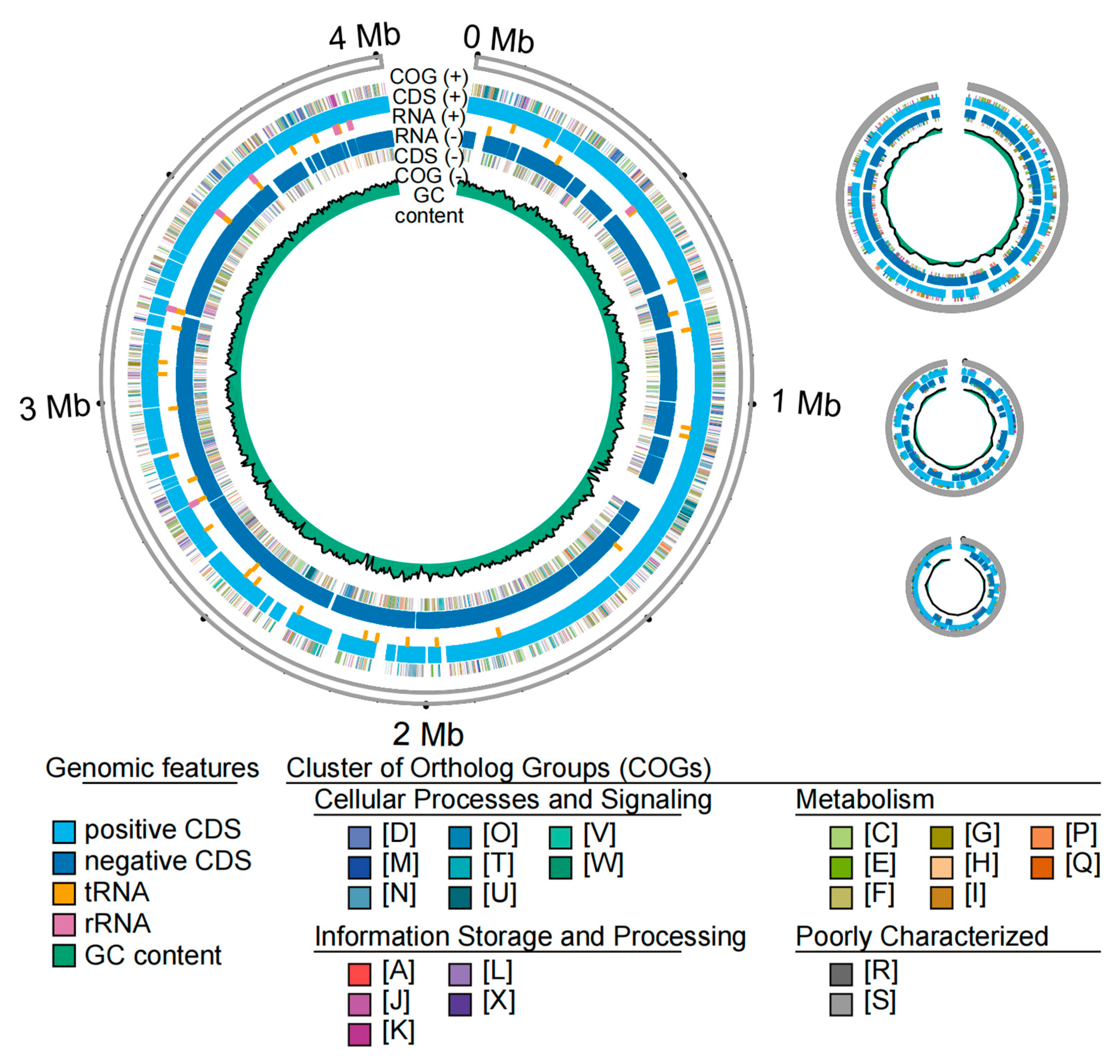
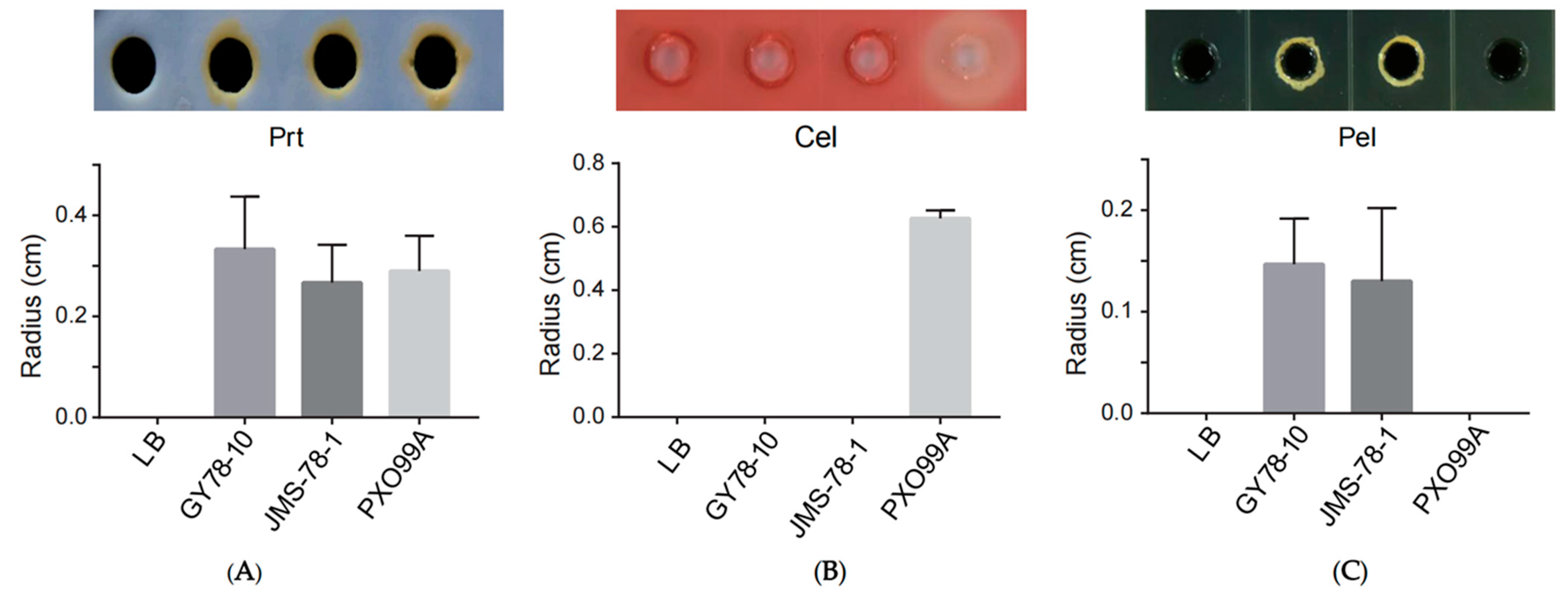
| Gene | Primer | Primer Sequence | Template Size (bp) | Reference |
|---|---|---|---|---|
| FusA | fusA3 | 5′-CATCGGTATCAGTGCKCACATCGA-3′ | 588 | [37] |
| fusA4 | 5′-CAGCATCGCCTGAACRCCTTTGTT-3′ | |||
| leuS | leuS3 | 5′-CAGACCGTGCTGGCCAACGARCARGT-3′ | 643 | [36] |
| leuS4 | 5′-CGGCGCGCCCCARTARCGCT-3′ | |||
| pyrG | pyrG3 | 5′-GGGGTCGTATCCTCTCTGGGTAAAGG-3′ | 306 | |
| pyrG4 | 5’GGAACGGCAGGGATTCGATATCNCCKA-3’ | |||
| rplB | rplB3 | 5’-CAGTTGAACGTCTTGAGTACGATCC-3’ | 333 | |
| rplB4 | 5’-CACCACCACCATGYGGGTGRTC-3’ | |||
| gyrB | gyrB3 | 5GCGTAAGCGCCCGGGTATGTA-3’ | 722 | |
| gyrB4 | 5’-CCGTCGACGTCCGCATCGGTCAT-3’ |
| Genomic Features | GY78-10 |
|---|---|
| Total length of clean reads (bp) | 903,572,889 |
| GC content (%) | 54.35 |
| Chromosome | 1 |
| Chromosome length (bp) | 4,008,345 |
| Plasmids | 3 |
| Total genes | 4587 |
| Total protein-coding genes | 4378 |
| Pseudogenes | 2 |
| Ribosomal RNA genes | 22 |
| Transfer RNA genes | 78 |
| Other non-coding RNA genes | 107 |
| Features | Name | Number | Component Number | Core Structure |
|---|---|---|---|---|
| Secretion System | T1S | 1 | 3 | complete |
| T2S | 0 | 0 | lost | |
| T3S (Flagellar) | 1 | 11 | defective | |
| T4S | 1 | 9 | defective | |
| T5S | 1 | 1 | defective | |
| T6S | 2 | 14 | complete/2 Locus | |
| Genomic island | 11 | 27/13/18/10/9/30/14/44/7/14/27 | ||
| Pathogenicity | 350 | |||
| Secondary metabolite biosynthesisgene clusters | arylpolyene | 1 | 61 | |
| terpene | 1 | 28 | ||
| NI-siderophore | 1 | 26 |
Disclaimer/Publisher’s Note: The statements, opinions and data contained in all publications are solely those of the individual author(s) and contributor(s) and not of MDPI and/or the editor(s). MDPI and/or the editor(s) disclaim responsibility for any injury to people or property resulting from any ideas, methods, instructions or products referred to in the content. |
© 2025 by the authors. Licensee MDPI, Basel, Switzerland. This article is an open access article distributed under the terms and conditions of the Creative Commons Attribution (CC BY) license (https://creativecommons.org/licenses/by/4.0/).
Share and Cite
Duan, G.; Liu, X.; Zhang, S.; Chai, M.; Peng, Z.; Lin, Z.; Li, D.; Sun, W. An Emerging Bacterial Leaf Disease in Rice Caused by Pantoea ananatis and Pantoea eucalypti in Northeast China. Microorganisms 2025, 13, 1376. https://doi.org/10.3390/microorganisms13061376
Duan G, Liu X, Zhang S, Chai M, Peng Z, Lin Z, Li D, Sun W. An Emerging Bacterial Leaf Disease in Rice Caused by Pantoea ananatis and Pantoea eucalypti in Northeast China. Microorganisms. 2025; 13(6):1376. https://doi.org/10.3390/microorganisms13061376
Chicago/Turabian StyleDuan, Guohua, Xin Liu, Shaoqi Zhang, Mengzhu Chai, Zhao Peng, Zihan Lin, Dayong Li, and Wenxian Sun. 2025. "An Emerging Bacterial Leaf Disease in Rice Caused by Pantoea ananatis and Pantoea eucalypti in Northeast China" Microorganisms 13, no. 6: 1376. https://doi.org/10.3390/microorganisms13061376
APA StyleDuan, G., Liu, X., Zhang, S., Chai, M., Peng, Z., Lin, Z., Li, D., & Sun, W. (2025). An Emerging Bacterial Leaf Disease in Rice Caused by Pantoea ananatis and Pantoea eucalypti in Northeast China. Microorganisms, 13(6), 1376. https://doi.org/10.3390/microorganisms13061376





